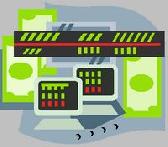
 |
|
| Financial Terms | |
| VARIABLE EXPENSES |
|
Information about financial, finance, business, accounting, payroll, inventory, investment, money, inventory control, stock trading, financial advisor, tax advisor, credit.
Main Page: inventory control, credit, accounting, tax advisor, financial advisor, investment, stock trading, money, |
Definition of VARIABLE EXPENSES
VARIABLE EXPENSESThose that vary with the amount of goods you produce or sell. These may include utility bills, labor, etc. variable expensesexpenses that change with changes in either sales volume
Related Terms:unit marginThe profit per unit sold of a product after deducting product segment marginthe excess of revenues over direct variable expenses and avoidable fixed expenses for a particular segment Annual fund operating expensesFor investment companies, the management fee and "other expenses," Continuous random variableA random value that can take any fractional value within specified ranges, as Discrete random variableA random variable that can take only a certain specified set of discrete possible Endogenous variableA value determined within the context of a model.  Exogenous variableA variable whose value is determined outside the model in which it is used. Also called Normal random variableA random variable that has a normal probability distribution. Random variableA function that assigns a real number to each and every possible outcome of a random experiment. VariableA value determined within the context of a model. Also called endogenous variable. Variable annuitiesAnnuity contracts in which the issuer pays a periodic amount linked to the investment Variable costA cost that is directly proportional to the volume of output produced. When production is zero, Variable life insurance policyA whole life insurance policy that provides a death benefit dependent on the Variable price securityA security, such as stocks or bonds, that sells at a fluctuating, market-determined price. Variable rate CDsShort-term certificate of deposits that pay interest periodically on roll dates. On each roll  Variable rated demand bond (VRDB)Floating rate bond that can be sold back periodically to the issuer. Variable rate loanLoan made at an interest rate that fluctuates based on a base interest rate such as the GENERAL-AND-ADMINISTRATIVE EXPENSESWhat was spent to run the non-sales and non-manufacturing part of a company, such as office salaries and interest paid on loans. OPERATING EXPENSESThe total amount that was spent to run a company this year. SELLING EXPENSESWhat was spent to run the sales part of a company, such as sales salaries, travel, meals, and lodging for salespeople, and advertising. ExpensesThe costs incurred in buying, making or producing goods and services. Semi-variable costsCosts that have both fixed and variable components. Variable costA cost that increases or decreases in proportion with increases or decreases in the volume of production of goods or services. Variable costingA method of costing in which only variable production costs are treated as product costs and in which all fixed (production and non-production) costs are treated as period costs. Accrued expenses payableexpenses that have to be recorded in order for the financial statements to be accurate. Accrued expenses usually do not involve the receipt of an invoice from the company providing the goods or services. ExpensesCosts involved in running the company.  Prepaid expensesexpenses that have been paid for but have not yet been used up; examples are prepaid insurance and prepaid rent. accrued expenses payableThe account that records the short-term, noninterest- fixed expenses (costs)expenses or costs that remain the same in amount, revenue-driven expensesOperating expenses that vary in proportion to unit-driven expensesexpenses that vary in close proportion to changes decision variablean unknown item for which a linear programming dependent variablean unknown variable that is to be predicted independent variablea variable that, when changed, will key variablea critical factor that management believes will slack variablea variable used in a linear programming problem surplus variablea variable used in a linear programming problem that represents overachievement of a minimum requirement; it is associated with greater-than-or-equal-to constraints variable costa cost that varies in total in direct proportion variable costinga cost accumulation and reporting method variable cost ratiothe proportion of each revenue dollar variable overhead efficiency variancethe difference between budgeted variable overhead based on actual input activity and variable overhead applied to production variable overhead spending variancethe difference between total actual variable overhead and the budgeted amount of variable overhead based on actual input activity Variable costA cost that changes in amount in relation to changes in a related activity. variable costsCosts that change as the level of output changes. Fixed ExpensesCost of doing business which does not change with the volume of business. Examples might be rent for business premises, insurance payments, heat and light. Operating ExpensesThe amount of money the company must spend on overhead, distribution, taxes, underwriting the risk and servicing the policy. It is a factor in calculating premium rates. Variable AnnuityA form of annuity policy under which the amount of each benefit is not guaranteed or specified. The amounts fluctuate according to the earnings of a separate investment account. contribution marginAn intermediate measure of profit equal to sales revenue gross margin, or gross profitThis first-line measure of profit Related to : financial, finance, business, accounting, payroll, inventory, investment, money, inventory control, stock trading, financial advisor, tax advisor, credit. |